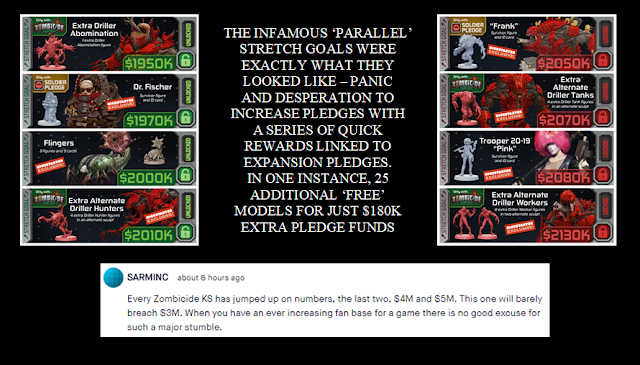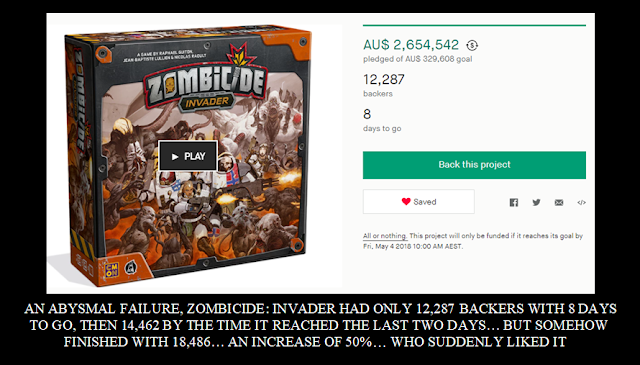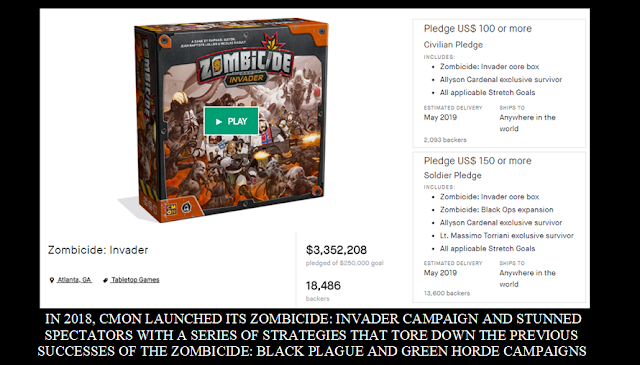ZOMBICIDE: INVADER EPIC FAIL – PART 1
NOT QUITE DEAD
CMON. The potential
answer to the question about who will move into the market vacuum as Games
Workshop (GW) gradually, but inevitably, vanishes into the abyss. We have watched
GW abuse, violate, alienate, exile, and basically shit all over its market for
decades. It literally relied upon regeneration to make massive profits by
charging outrageous prices for product worth a tiny fraction of that, and responded
to criticism with casual disregard as one generation left and the next moved
into its place.
Despite
the many, many ‘stories’ from former customers and staff, it’s incredibly
difficult to find any of it posted on the internet. GW itself ruthlessly purges
negative feedback on its own sites, and where they find sites even mentioning their
products, threatens legal action to silence the authors and, in some cases,
literally steals ideas under the claim those ideas contain GW ‘intellectual
property’. It doesn’t take much. Just the use of a word from their own ranges
will do, or an image that looks similar, even if it isn’t even their ‘intellectual
property’ at all.
One of the
biggest ‘stories’ exposing the vile, predatory behaviour of GW actually
involved a legal battle over the use of the word ‘Space Marine’ in a book
titled Spots the Space Marine. GW
claimed it was theirs. Anybody who reads science fiction will, however, be well
aware the term predates the company by several decades, and even imagery that
appeared on a book including that term (long before the company was associated
with it) appears to have been appropriated by GW. But GW has built its empire
on the not quite dead corpses of its victims, and CMON has been watching… and
learning… to imitate.
You
may remember my post about Zombicide:
Green Horde and the potential for serious failure if CMON did not adapt to
its market and learn from the mistakes of GW. One of the key points I mentioned
was the need to take action against its little band of camp followers trolling
people who dared to suggest anything with which those puritanical zealots
disagreed. I stated a failure to act would encourage and enable those trolls,
and that this would lead to similar consequences to those that afflicted GW.
GW, when confronted with the same problem,
actually did the opposite. Not only did they encourage bad behaviour, they
modelled it. At the time my initial post about this was published, I’d pointed
out that CMON was moving into the market GW had so foolishly mistreated and
cast aside. In that post I’d also suggested CMON would soon make efforts to
move further into that market. Well, if you’ve been paying attention, you will
have noticed Zombicide: Invader… and
just how badly the campaign to massively profit from this territorial grab has
failed. It always feels good to be vindicated.
Now, while
it won’t take long to find CMON’s horde of colon crawlers trolling people like
me (who point out what is so blatantly obvious), you will be hard pressed to
find feedback like mine, or even comlaints about poor service and broken or missing
product people purchased. You won’t find it on the campaign pages, or on CMON’s
Facebook page. CMON purges anything criticising its product and actions, then
blocks whoever posted it. Sound familiar? Clearly, the imagery and content
produced by GW isn’t the only thing CMON has appropriated in its effort to
claim and control that market.
But to get
a really good understanding of why things went so badly, first you need to have
a look at where Zombicide: Invader
came from. Well, aside from straight out of GW’s decades of Warhammer 40,000. It was actually an
attempt to move the Zombicide: Black
Plague fantasy setting into a galactic scale science fiction setting, most
likely to capitalise on the popularity of GW’s game of Necromunda. Necromunda was
rereleased last year by GW in order to make some more quick short-term profits,
and will vanish again just as quickly, like all the other games they promote
this way.
Unlike the
original release, however, GW has gone overboard with the background literature
and rules. They’ve added cards and departed from the original to create
super-human (almost alien) Marvel style gangs… with poorer quality, plastic
models that start at US$40 for ten. Even the game seems to have borrowed
heavily from the Zombicide flat-tile
format, no longer providing rules for vertical activity… unless, of course, you
buy the additional, supplemental, expansions. Which adds to the original spend,
and keeps adding to it. Some things just don’t change.
GW
and CMON seem to have adopted ‘parallel’ game formats and rip-off-while-shitting-on-their-market
strategies, but CMON has one advantage over GW that they seem hell bent on
squandering: price. While Necromunda
was a great game, Zombicide remained
incredibly popular for several reasons. The great artwork, relatively good
models and simple (if incredibly restrictive) rules, and a price comparatively
cheap and affordable to what GW charges (between 10 to 25%, depending on the
model).
GW had
been using a strategy of publishing deliberately flawed, extremely complicated,
unmanageable rules, combined with dozens of individual Codex or Army books for
each of the main armies, then doing it all over again a few years later for the
new and ‘improved’ edition. The new editions usually had minor changes that
required players to spend a small fortune on new models and resources. In some
cases the new ones followed the last ‘updated’ Army or Codex book from the
previous edition by mere weeks.
At
one point there were even five separate Codex Space Marine supplements during a
single edition of the game, and players of other armies never saw updates for
five or more years, their armies rendered completely obsolete as they were
outclassed and effectively unplayable for that time. It was a strategy designed
to get suckers to spend money on the newest releases, and saw players fleeced
in an endless procession. Those bled dry left and were replaced as the next
generation was sucked in, so incredibly arrogant and all-knowing they refused
to heed the warnings of better, more experienced victim-players until they,
too, joined the ranks of the departed and were treated with the same contempt.
Zombicide: Black Plague
capitalised on this frustration. Hell, it even included contributions from
former GW staff like Adrian Smith and Karl Kopinski. It was abundantly clear
what CMON was attempting to do. But while GW used the ‘updated’ editions of its
games to release new Codex and Army books, complete with new models to form
units slightly more powerful than previous armies to stimulate sales, Black Plague just gave players a pile of
models and rules that remained constant. Plus, as mentioned, they were dirt
cheap by comparison, albeit with a number of cons.
Prices at
GW varied a great deal. Some plastic miniatures were only US$4 each, provided
you purchased them in boxes of ten. Other models could cost well over US$100.
These were often multipart kits that required assembly, allowing different
poses to be created, but could easily be broken. CMON produced plastic models
with a price tag of around US$1 each if purchased during a kickstarter… but
double that at retail. These were usually one-piece or pre-assembled. They were
not, in any way, of comparable quality. The 3D renders looked good, but the end
product wasn’t as durable or impressive.
Either
way, Zombicide was seen as a much
better deal than Necromunda (or the fantasy
version called Mordheim) because it
provided far more models at a much cheaper price. Until expansions and Optional
buys were added. The Core Box was a comparable price to some of the smaller GW
ones but more value for money. Expansions and Optional buys were value for
money too, but added up, especially if content was exclusive and had to be
purchased at the same time as the Core Box to secure it.
But this
is about how CMON took a great product that quickly gained a very large
following… and then inflicted the same idiotic strategies on their market that
smarter people had watched GW attempt over the years. Some of the few surviving
sites criticising what GW had done included colourful suggestions that what had
occurred be included in books for people studying business… under titles like
“What Not to Do In Business.” So let’s take a look at what CMON did, and why it
was such an epic fail.










Comments
Post a Comment